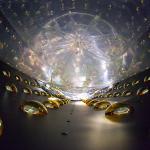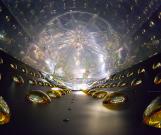Neutrino 2018: What’s all the fuss about?

June 8, 2018 by Bruno Martin
Billions of neutrinos fly through our bodies every second, unnoticed. These puny, chargeless particles are the most abundant in the universe: they currently outnumber electrons, protons and neutrons by a factor of 10 billion. But despite their everyday presence, neutrinos are one of modern physics’ biggest head-scratchers. Twenty years ago, the discovery that neutrinos can change from one of three known types into another proved that they must have mass, breaking a key prediction of the Standard Model of particle physics. According to the theory which had hitherto described the properties and behaviour of the universe accurately, the neutrino should be massless — but it isn’t. That discrepancy was just a beginning; today, physicists all over the world grapple with several riddles of cosmic proportions posed by the troublesome behaviour of neutrinos. Many of these researchers are currently in an auditorium in Heidelberg, Germany, putting their heads together for Neutrino 2018, the XXVIII International Conference on Neutrino Physics and Astrophysics.
At Neutrino 2018, researchers from several international collaborations present their experimental results and current theories on neutrino behaviour. The design of the experiments is varied, from gigantic detectors for cosmic and atmospheric particles, like Super-Kamiokande in Japan and IceCube in Antarctica, to man-made neutrino sources, including accelerated beams and nuclear reactors. They all aim to answer questions about the properties of neutrinos, which are fascinating of themselves, but may actually help piece together the bigger puzzles of physics: How much do neutrinos weigh? Is there a fourth (even more elusive) type of neutrino? Are neutrinos their own antiparticles? These are the questions that may help us understand how the universe was born, why everything is made of matter, what happens when stars explode, and whether we are on the doorstep of understanding physics beyond the Standard Model.
Antiparticles do it too
Neutrinos come in three types, or flavours —electron, muon and tau— and they can change from one flavour into another when travelling over long distances, a process known as oscillation. This requires neutrinos to have mass. In fact, each neutrino is a combination of three possible mass states. While the mass differences are known, their exact value is not. This means that there are two possible mass orderings: normal and inverted. Current evidence points to a normal ordering, but the jury is still out. Experiments which send beams of neutrinos through long swathes of the Earth’s crust aim to ‘catch’ a small number of them as they exit the ground to check which proportion has oscillated into a new flavour. Precise measurements of this process will help physicists figure out the mass ordering.
On Monday, representatives of the NOvA collaboration —which beams neutrinos from Fermilab, Illinois, to Minnesota— presented strong evidence at Neutrino 2018 of muon antineutrinos oscillating into electron antineutrinos, a phenomenon hinted at in previous results from the T2K experiment in Japan. NOvA is designed to tackle the mass ordering problem but had so far only published results involving neutrino oscillations, and not their antiparticle counterparts. Theory predicts neutrinos and antineutrinos should be identical in all but their chirality, which can be thought of as a property akin to their rotation. Adding to these data, the Daya Bay Reactor Neutrino Experiment also presented new results at the conference on Tuesday. This experiment uses eight antineutrino detectors to observe the (anti)particles produced by the Daya Bay Nuclear Power Plant in Southern China.
Cheating physics
Normally, particles come with matching antiparticles, identical in mass but opposite in charge. Both are thought to have appeared in equal measure during the early universe, but matter dominates the world today. This is odd, because matter and antimatter annihilate when they collide, which means there shouldn’t be anything but energy if there really was a cosmic balance. Since neutrinos are a special sort of particle, devoid of charge and with fluctuating properties, researchers are hoping they might provide a clue to this asymmetry. If the antineutrinos studied at NOvA, for example, are found to oscillate at different rates to their corresponding neutrinos, this would be a valuable lead into what scientists call CP-violation, which is the breaking of symmetry.
Neutrinos may be capable of other sorts of fouls. Another way of breaking symmetry is known as lepton number violation, which would be confirmed if neutrinos and antineutrinos are found to be one and the same. On Wednesday, the topic of discussion at Neutrino 2018 was a hypothetical process, known as neutrinoless double-beta decay, that occurs if neutrinos are “Majorana particles”, that is, their own antiparticles (as opposed to Dirac particles like the electron). In some heavy and unstable atoms, two neutrons may spontaneously transform into protons, ejecting an electron and a neutrino each: two beta decay events, hence “double”. “Neutrinoless” would be the result of both neutrinos annihilating each-other, as particle-antiparticle pairs do. We don’t know that this happens, but confirmation of such an event would prove the Majorana nature of the neutrino. Unfortunately, neutrinoless double-beta decay, if it happens at all, is expected to be a rare event. The GERDA collaboration, which presented new results on Wednesday, operates a germanium array as source for beta decays in Italy, but predicts fewer than one yearly event per kilogram of material.
But wait... there's more
These are just some of the many avenues of research available to neutrino physicists. Another hot topic is whether there is a fourth flavour of “sterile” neutrinos that interact even more rarely with matter, their presence hinted at in a decades-old experiment. Just before the conference started, the MiniBooNE experiment in Fermilab, near Chicago, reported detection of an abnormally large number of electron neutrinos very close to their muon neutrino source. The results are most easily explained by the presence of the sterile neutrino, although other lines of evidence for its existence have been weakening in recent years.
In other news, the KATRIN experiment, which has its official inauguration next Monday, when the conference finishes, presented yesterday data collected just three weeks ago. KATRIN gauges the energy of electrons ejected in the decay of radioactive tritium to measure the absolute (combined) mass of the three types of neutrinos.
Finally, some neutrino studies aim to directly probe the sturdiness of the Standard Model. Such is the COHERENT experiment, a tiny neutrino detector designed to observe the “coherent elastic neutrino-nucleus scattering” predicted decades ago — in which exploding supernovae cause neutrinos to run into atom nuclei, producing a very weak ‘recoil’ energy that is hard to detect. COHERENT measured the expected signal last summer, and their results were discussed yesterday at the conference.
Much has changed for this discipline in the last decades; it’s certainly an exciting time to be a neutrino physicist. Experiments are constantly being upgraded in order to push measurements closer to the levels of accuracy required for testing theory. New collaborations, larger than any before, are being born, such as the Deep Underground Neutrino Experiment, which will project the largest neutrino beam to date, covering 1,300 kilometres from Illinois to South Dakota. Every day that scientists chip away at the neutrino enigmas, we come a little closer to understanding the world.
Text by Bruno Martin, with helpful comments from Xabier Marcano and Olga Mena.
This project has received funding/support from the European Union’s Horizon 2020 research and innovation programme under the Marie Sklodowska-Curie grant agreement No 674896.



